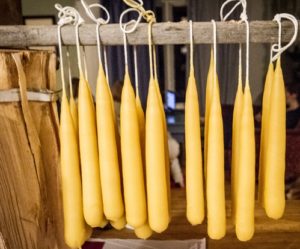-
 During the dark days of winter in Colonial times, candles served as the only source of light in the evening. Most families created “dipped” candles from beeswax, tallow, or wax made from bayberries. Assisting with candle making was an important chore for a Colonial child. They could help with gathering bay-berries and boiling them (it took some 15 pounds of boiled berries to make one pound of poured wax!), or harvesting beeswax, melting it, snipping wicks, and patiently dipping. At this candle making workshop, children can try their hand at dipping candles and learn about life in Colonial Connecticut from Museum Education Katherine Karlick. Kids can help make their own snack – fruit dipped in chocolate.
During the dark days of winter in Colonial times, candles served as the only source of light in the evening. Most families created “dipped” candles from beeswax, tallow, or wax made from bayberries. Assisting with candle making was an important chore for a Colonial child. They could help with gathering bay-berries and boiling them (it took some 15 pounds of boiled berries to make one pound of poured wax!), or harvesting beeswax, melting it, snipping wicks, and patiently dipping. At this candle making workshop, children can try their hand at dipping candles and learn about life in Colonial Connecticut from Museum Education Katherine Karlick. Kids can help make their own snack – fruit dipped in chocolate.
Wilton Historical Society Members $10 per child; Non-members $15 per child. Please register: info@wiltonhistorical.org or call 203-762-7257.
Did you know?
Colonial women offered America’s first contribution to candle making, when they discovered that boiling the grayish-green berries of bayberry bushes produced a sweet-smelling wax that burned cleanly. However, extracting the wax from the bayberries was extremely tedious. As a result, the popularity of bayberry candles soon diminished.
The growth of the whaling industry in the late 18th century brought the first major change in candle making since the Middle Ages, when spermaceti — a wax obtained by crystallizing sperm whale oil — became available in quantity. Like beeswax, the spermaceti wax did not elicit a repugnant odor when burned, and produced a significantly brighter light. It also was harder than either tallow or beeswax, so it wouldn’t soften or bend in the summer heat. Historians note that the first “standard candles” were made from spermaceti wax. From the National Candle Association.